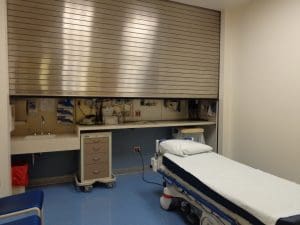Behavioral Health Security Assessment
Have you performed an assessment of you behavioral health security measures in your mental health unit, or your processes for the handling of mental health patients in your emergency department? Are you following best practices?
Behavioral Health Security Risks
With the decreased number of licensed mental health treatment facilities across the United States comes the fact that hospitals are often the first stop for many patients with mental health issues, and as a result hospitals must consider their behavioral health security measures.
When law enforcement officials encounter someone in their jurisdiction that is a danger to themselves or others, they will often take custody of that person and transport them to a medical center in most cases for evaluation.
According to the Emergency Medical Treatment & Labor Act (EMTALA), once a patient presents at a hospital they must be treated and cannot be turned away. That being the case, even those hospitals that are not mental health treatment centers must conduct a medical assessment on the patient and then they are responsible for locating a facility that can take the patient for treatment.
When you are talking about locating a properly designated treatment facility for mental health patients, you have to keep in mind that in some cities and states this may require numerous phone calls and hours of delay in getting treatment for the patient. That being the case, there are several security concerns that need to be taken into consideration for the behavioral health patient, as well as the hospital staff and other patients and visitors.
Patient Suicide Risk Factors
Depending on where you place at risk patients while they await transfer to an inpatient bed, or another facility, a healthcare organization needs to conduct a risk assessment in the patient care areas looking for things such as hazards that could be used by a patient to harm themselves. There are numerous guidelines and best practices when it comes to identifying and reducing such risks, yet many hospitals have never taken the proper steps to review their facilities.
Patient Elopements
There is a high risk factor for patient elopements from the E.D. for those patients that have been deemed a danger to themselves or others. This type of patient has eloped from emergency departments across the country and in some cases they have committed serious offenses such as murder after they eloped, or they have intentionally harmed themselves or been accidentally killed when fleeing.
In other cases at risk patients that have eloped from the E.D. have been pursued by untrained hospital security or law enforcement and have been injured when they were apprehended. That being the case, what is your organization’s plan to address elopements of at risk patients, and what training do you provide your staff?
Emergency Department Security
The potential for violence within an emergency department (E.D.) is often elevated. In fact, many healthcare workers have been seriously injured while working in the emergency department, more so than other areas of hospital. With the increased risks for violence, security has to be a top priority for the emergency department and in many cases the staffing of at least one security officer in the E.D. should be a priority.
Security Training
The training required for staff working in the E.D. should be comprehensive and ongoing. In some states it is required by law, and accreditation agencies may also require it as a standard.
Staff that works in the emergency department must be trained in managing aggressive behavior. Hospitals also need to consider that staff’s behavior, voice tone and volume, may increase the risks of patients acting out.
Another important factor is that places such as the emergency room can be very stimulating for people that do not work in it, and even the most rational person may get over stimulated while waiting to be seen in the E.D. When you take into consideration that a patient or family member may already be under a great deal of stress before they walk in the doors, adding in all the sights and sounds of the department can further aggravate their stress levels and may lead them to act out inappropriately.
Behavioral Health Patient Watches
The job of watching a mental health hold patient in the Emergency department can be assigned to a number of different employees. For example, in many healthcare organizations they will have behavioral health specialist performing this duty. In others we have seen CNAs, department secretaries and clerical staff watch patients. One of the common types of employees tasked with patient watches is security officers, even though there can be a very limited number of security officers working and they have many responsibilities with their job. The thing to remember is that it does not have to be a security officer in most cases.
Regardless of who is assigned to watch at risk patients, those that are assigned patient watches must be properly trained and qualified to perform such duties. Hospitals have been fined for not properly training staff on how to perform patient watches.




